Emergency obstetric and neonatal care availability, use, and quality: a cross-sectional study in the city of Lubumbashi, Democratic Republic of the Congo, 2011
- PMID: 28103822
- PMCID: PMC5244553
- DOI: 10.1186/s12884-017-1224-9
Emergency obstetric and neonatal care availability, use, and quality: a cross-sectional study in the city of Lubumbashi, Democratic Republic of the Congo, 2011
Abstract
Background: While emergency obstetric and neonatal care (EmONC) is a proxy indicator for monitoring maternal and perinatal mortalities, in Democratic Republic of the Congo (DRC), data on this care is rarely available. In the city of Lubumbashi, the second largest in DRC with an estimated population of 1.5 million, the availability, use and quality of EmONC are not known. This study aimed to assess these elements in Lubumbashi.
Methods: This cross-sectional survey was conducted in April and May 2011. Fifty-three of the 180 health facilities that provide maternity care in Lubumbashi were included in this study. Only health facilities with at least six deliveries per month over the course of 2010 were included. The availability, use and quality of EmONC at each level of the health care system were assessed according to the WHO standards.
Results: The availability of EmONC in Lubumbashi falls short of WHO standards. In this study, we found one facility providing Comprehensive EmONC (CEmONC) for a catchment area of 918,819 inhabitants. Apart from the tertiary hospital (Sendwe), no other facility provided all the basic emergency obstetric and neonatal care (BEmONC) signal functions. However, all had carried out at least one of the nine signal functions during the 3 months preceding our survey: 73.6% of 53 facilities had administered parenteral antibiotics, 79.2% had systematically offered oxytocics, 39.6% had administered magnesium sulfate, 73.6% had manually evacuated placentas, 81.1% had removed retained placenta products, 54.7% had revived newborns, 35.8% had performed caesarean sections, and 47.2% had performed blood transfusions. Function 6, vaginal delivery assisted by ventouse or forceps, was performed in only two (3.8%) facilities. If this signal function was not taken into account in our assessment of EmONC availability, there would be five facilities providing CEmONC for 918,819 inhabitants, rather than one. In 2010, all the women in the surveyed facilities with obstetric complications delivered in facilities that had carried out at least one signal function in the 3 months before our survey; 7.0% of these women delivered in the facility which provided CEmONC. Mortality due to direct obstetric causes was 3.9% in the health facility that provided CEmONC. The intrapartum mortality was also high in this facility (5.1%). None of the maternity ward managers in any of the facilities surveyed had received training on the EmONC package. Essential supplies and equipment for performing certain EmONC functions were not available in all the surveyed facilities.
Conclusion: Audits of maternal and neonatal deaths and near-misses should be established and used as a basis for monitoring the quality of care in Lubumbashi. To reduce maternal and perinatal mortality, it is essential that staff skills regarding EmONC be strengthened, the availability of supplies and equipment be increased, and that care processes be standardized in all health facilities in Lubumbashi.
Keywords: Democratic Republic of the Congo; Maternal mortality; Maternal-Child Health Services; Obstetric labor complications; Perinatal care; Perinatal death.
Figures
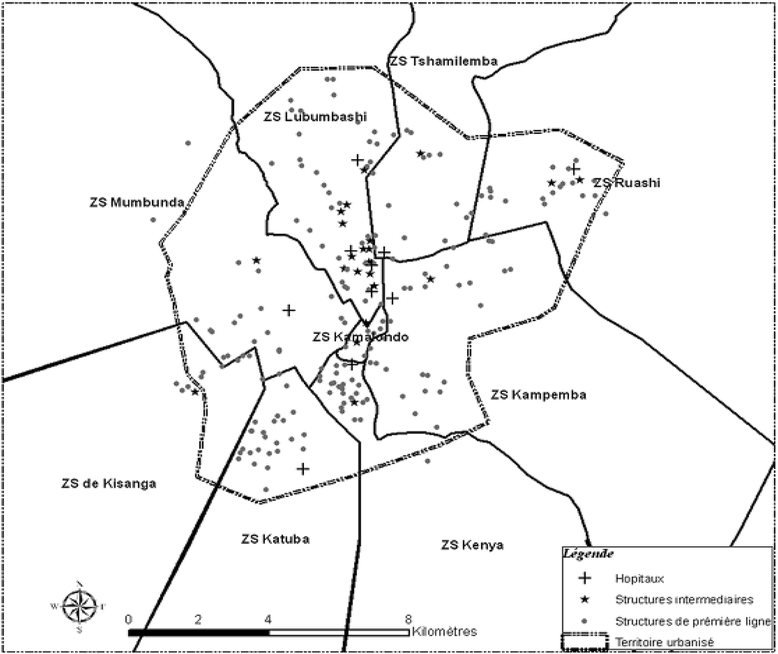
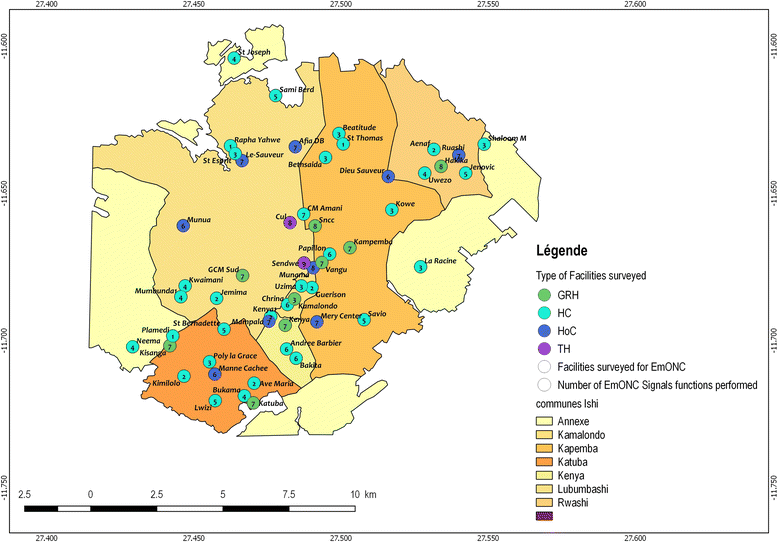
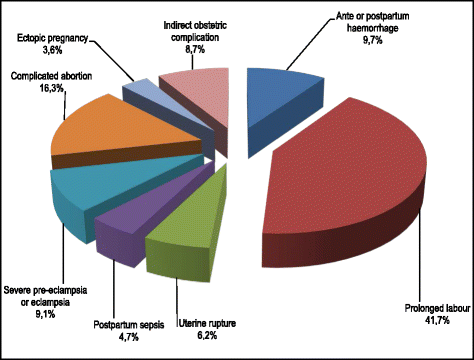
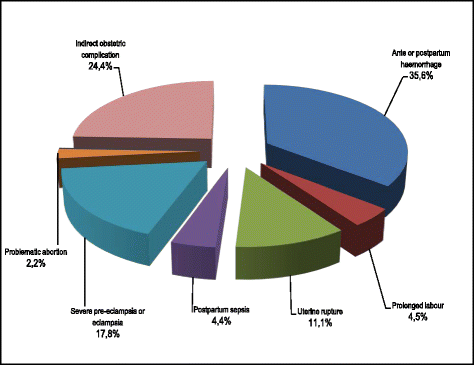
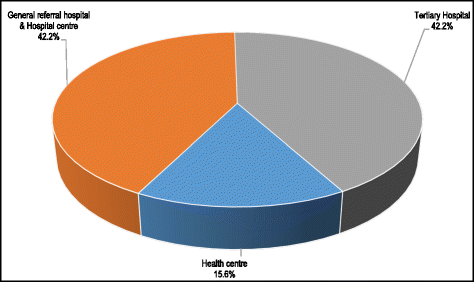
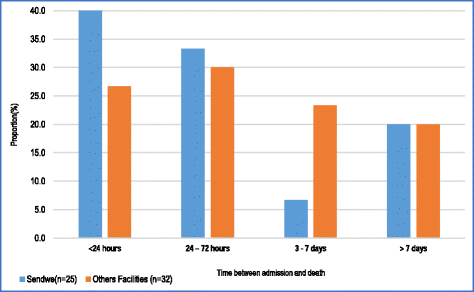
Similar articles
-
Evaluation of emergency obstetric and neonatal care services in Kumba Health District, Southwest region, Cameroon (2011-2014): a before-after study.BMC Pregnancy Childbirth. 2020 Feb 11;20(1):95. doi: 10.1186/s12884-020-2774-9. BMC Pregnancy Childbirth. 2020. PMID: 32046673 Free PMC article.
-
The status of maternal and newborn health care services in Zanzibar.BMC Pregnancy Childbirth. 2016 Jun 3;16(1):134. doi: 10.1186/s12884-016-0928-6. BMC Pregnancy Childbirth. 2016. PMID: 27259480 Free PMC article.
-
Signal functions for emergency obstetric care as an intervention for reducing maternal mortality: a survey of public and private health facilities in Lusaka District, Zambia.BMC Pregnancy Childbirth. 2017 Sep 6;17(1):288. doi: 10.1186/s12884-017-1451-0. BMC Pregnancy Childbirth. 2017. PMID: 28877675 Free PMC article.
-
Triangulating data sources for further learning from and about the MDSR in Ethiopia: a cross-sectional review of facility based maternal death data from EmONC assessment and MDSR system.BMC Pregnancy Childbirth. 2020 Apr 9;20(1):206. doi: 10.1186/s12884-020-02899-8. BMC Pregnancy Childbirth. 2020. PMID: 32272930 Free PMC article. Review.
-
A scoping review, mapping, and prioritisation process for emergency obstetric and neonatal quality of care indicators: Focus on provision and experience of care.J Glob Health. 2023 Oct 13;13:04092. doi: 10.7189/jogh.13.04092. J Glob Health. 2023. PMID: 37824168 Free PMC article.
Cited by
-
Quality of emergency obstetric and newborn care services in Wolaita Zone, Southern Ethiopia.BMC Pregnancy Childbirth. 2022 Sep 6;22(1):686. doi: 10.1186/s12884-022-05019-w. BMC Pregnancy Childbirth. 2022. PMID: 36068531 Free PMC article.
-
Reducing intrapartum fetal deaths through low-dose high frequency clinical mentorship in a rural hospital in Western Kenya: a quasi-experimental study.BMC Pregnancy Childbirth. 2019 Dec 23;19(1):518. doi: 10.1186/s12884-019-2673-0. BMC Pregnancy Childbirth. 2019. PMID: 31870325 Free PMC article. Clinical Trial.
-
Maternal and health service predictors of postpartum hemorrhage across 14 district, general and regional hospitals in Thailand.BMC Pregnancy Childbirth. 2020 Mar 18;20(1):172. doi: 10.1186/s12884-020-2846-x. BMC Pregnancy Childbirth. 2020. PMID: 32183723 Free PMC article.
-
Distribution and quality of emergency obstetric care service delivery in the Democratic Republic of the Congo: it is time to improve regulatory mechanisms.Reprod Health. 2019 Jul 15;16(1):102. doi: 10.1186/s12978-019-0772-z. Reprod Health. 2019. PMID: 31307497 Free PMC article.
-
Neonatal indicator data in Tanzania District Health Information System: evaluation of availability and quality of selected newborn indicators, 2015-2022.BMC Pediatr. 2025 Jan 23;23(Suppl 2):658. doi: 10.1186/s12887-025-05417-x. BMC Pediatr. 2025. PMID: 39849367 Free PMC article.
References
-
- Kassebaum NJ, Bertozzi-villa A, Coggeshall MS, Shackelford KA, Steiner C, Heuton KR, et al. Global, regional, and national levels and causes of maternal mortality during 1990–2013: a systematic analysis for the Global Burden of Disease Study 2013. Lancet. 2014;384:980–1004. doi: 10.1016/S0140-6736(14)60696-6. - DOI - PMC - PubMed
-
- World Health Organization . Neonatal and Perinatal Mortality: Contry, Regional and Global Estimates 2004. Geneva: World Health Organization; 2004.
-
- Lawn J, Kerber K. Donnons sa chance à chaque nouveau-né de l’Afrique: données pratiques, soutien programmatique et de politiques pour les soins du nouveau-né en Afrique. éds. Partenariat pour la Santé maternelle, néonatale et infantile, Cape Town, 2006.
-
- Organisation Mondiale de la Santé. La stratégie mondiale pour la santé de la femme, de l’enfant et de l’adolescent (2016–2030). Genève; 2015.
MeSH terms
LinkOut - more resources
Full Text Sources
Other Literature Sources
Medical
Miscellaneous

